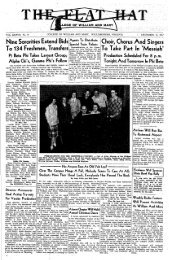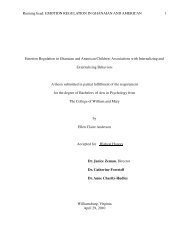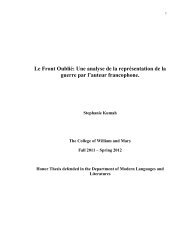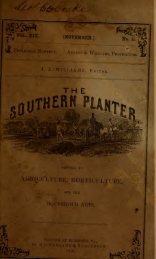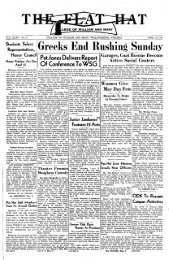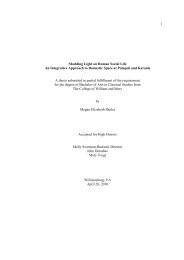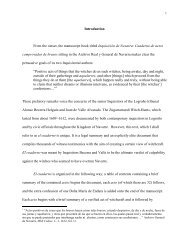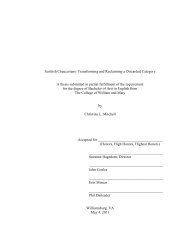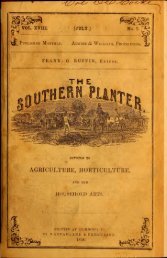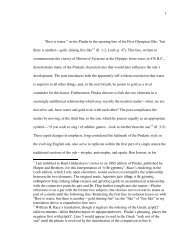Southern planter - The W&M Digital Archive
Southern planter - The W&M Digital Archive
Southern planter - The W&M Digital Archive
You also want an ePaper? Increase the reach of your titles
YUMPU automatically turns print PDFs into web optimized ePapers that Google loves.
1908.]<br />
oial fertilizer, at present prices, about twenty cents per<br />
pound, it will be seen that there is about $28.00 worth ol<br />
nitrogen in a seventy-five bushel crop of corn, and as it<br />
is impossible to recover all the nitrogen supplied in the<br />
form of fertilizer, it would take considerably more than<br />
this amount to produce seventy-five bushels of corn. As<br />
a matter of fact, it can be seen that it will be absolutely<br />
necessary to resort to the use of legumes or some cheaper<br />
source of nitrogen than that of commercial fertilizers<br />
If corn production is to be profitably maintained on our<br />
soils.<br />
In an address I made at the Normal Farmers' Institute<br />
of Pennsylvania, at Clearfield, in May, 1906, I took the<br />
stand that where a farmer whose interest is in grain or<br />
cotton, farms in a short rotation and brings in legume<br />
crops frequently on his land and feeds them, and saves<br />
the manure, he can keep his soil improving and never<br />
buy an ounce of nitrogen in any form. Some considered<br />
the statement rather broad, but every year the experiments<br />
at the Stations continue to show that on the corn<br />
crop especially it never pays to buy a complete fertilizer,<br />
and it is getting more and more evident that the same<br />
is true of the wheat crop. <strong>The</strong> men on the eastern shore<br />
of Maryland who have brought their lands up to the<br />
average of forty bushels of wheat per acre are the ones<br />
who years ago abandoned the purchase of nitrogen altogether<br />
and are using only acid phosphate and potash.<br />
Another interesting item in this Indiana bulletin is the<br />
statement in regard to the relative value of floats or pul-<br />
verized raw rock and the dissolved rock or acid phosphate.<br />
In 1906 an application of 1,000 pounds of the raw<br />
phosphate rock increased the corn crop twenty bushels<br />
per acre, while an application of 715 pounds of acid phos-<br />
phate, costing the same amount of money, made an<br />
increase of five bushels less than the raw rock. On<br />
the wheat crop the first season the acid phosphate was<br />
away ahead, but in two years thereafter the rock was<br />
ahead, showing that it was slower in coming into avail-<br />
ability. If used in connection with stable manure or with<br />
a sod turned under for corn, I believe that the floats<br />
will be the cheaper. <strong>The</strong> way that soil holds on to phos-<br />
phoric acid was well shown by an application three years<br />
before the corn crop, nothing having been applied in the<br />
meantime. <strong>The</strong> check plot made eighteen bushels per<br />
acre; the plot where acid phosphate had been applied<br />
three years before made thirty-three bushels per acre, and<br />
where rock floats had been applied three years before the<br />
crop was thirty-eight bushels per acre. At the Rothamsted<br />
Station in England, where 1,150 pounds of commer-<br />
cial fertilizer have been applied annually for fifty years,<br />
the average crop of wheat grown continuously on the<br />
land has been thirty-seven bushels per acre, and has been<br />
as high as forty-five bushels, while on another piece,<br />
where fourteen tons of stable manure have been applied<br />
every year for fifty years and wheat grown continuously,<br />
the average crop has been thirty-six bushels per acre<br />
and the highest forty-two bushels. This would seem to<br />
Indicate that fertilizers will maintain the productivity of<br />
the land, leaving profit out of view.<br />
<strong>The</strong> bulletin recommends for the <strong>Southern</strong> Indiana soils<br />
1. "<strong>The</strong> feeding of as much of the produce grown on the<br />
THE SOUTHERN PLANTER.<br />
land as possible and the return of the manure to the<br />
soil. 2. <strong>The</strong> practice of a systematic rotation of crops<br />
containing one or more of the legume crops in the series.<br />
.3 <strong>The</strong> liberal use of clover, cow peas or other legume<br />
crops is considered essential in order to keep up the nitro-<br />
rne si>W!?fX»r-J**4tfr?fji<br />
First Prize Dutch Belted Bull, Virginia State Fair, 1907.<br />
Owned by Mr. G. H. Dodge, Wilkinsonville, Mass.<br />
gen supply and keep the soil in good mechanical condition.<br />
<strong>The</strong> readers of this Journal will bear me out in saying<br />
that these are the very points I have been hammering<br />
at for many years. It all comes back to the fact that<br />
humus-making material is essential to the maintenance<br />
of the productivity of the soil, and when we can combine<br />
the nitrogen fixation with the humus-making we have<br />
reached the point where we can dispense with the nitrogen<br />
of the fertilizer manufacturer. I believe that it will<br />
be found in the long run that the use of phosphate rock<br />
finely pulverized will be found more profitable than the<br />
use of acid phosphate with the danger of depriving<br />
the soil of lime carbonate through its use, and the consequent<br />
souring of the soil. In a short rotation, where<br />
legume crops are frequently grown, the manure from<br />
feeding them and all the roughage and some of the grain<br />
raised carefully saved, and applied as fast as made, the<br />
soil will rapidly increase in humus and, with a soil<br />
abounding in humus, the pulverized floats can be profit-<br />
ably used, and will furnish phosphoric acid in greater sup-<br />
ply for the same money than acid phosphate will and,<br />
having the phosphorus in the soil, it will stay there till<br />
some crop calls for it. Hence, in the permanent improvement<br />
of the soil the floats will be a profitable investment.<br />
But floats applied to land from which the humus has been<br />
worn out will be very slow in making any returns, and<br />
until there is a considerable improvement in the humus<br />
content of the soil it will be better to use the acid phos-<br />
phate, and the place where this and potash will pay best<br />
in the improvement of the soil is on the pea crop that<br />
will give you forage and humus-making material. Feed<br />
the legumes liberally with the mineral plant foods and<br />
you can depend on their doing the rest.<br />
W. F. MASSEY.



